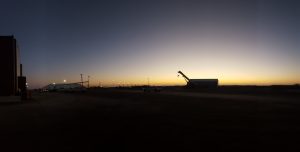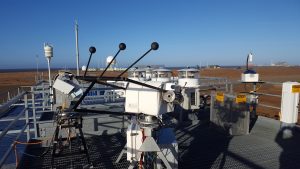It has been a while since we last posted, so let me fill you in. Where Gijs left off, POPEYE was under way at Oliktok and SODA flight team was working on permissions to fly the SeaHunter aircraft between the Kuparuk airport and the off-shore warning area where SeaHunter is cleared for flight operations. The solution to this problem is to have a manned chase plane to escort the UAS to and from the warning area. While UAF was securing an aircraft to perform this service, I remained in Colorado on standby. This delayed my arrival a few days until Sunday. I arrived in Kuparuk yesterday (Tuesday).
The oil fields in the Prudhoe Bay region, including Kuparuk, are amongst the largest oil fields on the North American continent. Our work is not concerned with oil, but rather sea ice. For us, operating on the North Slope from within the oil field is ultimately a matter of logistical convenience (and there is no shortage of logistics). Like Gijs, I spent a day at a training course in Anchorage to learn about how to safely travel and work in the Prudhoe region. Getting to the North Slope is actually quite easy. I flew direct from Denver to Anchorage and then (after training) from Anchorage to Deadhorse. In Deadhorse, I picked up our team’s rental truck (after phoning them Monday, the truck was conveniently left waiting for me in airport parking lot by the rental company, thanks!) and I drove about 30 miles west to Kuparuk, checking in with security along the way. The road is not paved, but is well used and traveled regularly by large trucks, so it is well maintained. We are based in Kuparuk because the Ugnu-Kuparuk airport is where the SeaHunter will take off and land. Like the oil field, the airfield is operated by ConocoPhillips and I am staying in their camp adjacent to the airport. Like many Arctic camps, this one is a complex series of interconnected and well-insulated buildings containing basic two-bed dorm rooms, cafeterias, common areas (including gyms and game rooms), medical services and so on. So far, I have lucked out because I have not yet been assigned a roommate!
The living is pretty comfortable. Before bed last night, I caught a bit of the that epic between the Cubbies and the Rockies, though I gave up just a bit too early at the top of the 13th. There is a lot of food available, whatever you want whenever you want it – very dangerous. Also, the coffee in the main cafeteria is actually quite good. But, I swear I’ve been doing more than eating cookies. Today was busy. The flight operations for the SeaHunter are complicated. Operating a UAS in a region as remote as is the Beaufort Sea means that it is imperative that the team remain acutely aware of weather conditions to make informed decisions. We are holding four conference calls each day that include not only ourselves (CIRES/NOAA and the SeaHunter flight team), but also aviation weather and sea ice forecasters from the National Weather Service (NWS) and others within NOAA and SODA. These calls are scheduled throughout the day and focus on outlooks over different periods of time from decisions on whether we fly or not in the morning to multi-day planning in the evening. Currently, the weather is very clear and sunny, but with very high easterly winds (sustaining up to 30 mph) associated with high pressure over the Beaufort Sea. The winds are typical, but this extended period of clear skies is quite unusual. The winds are too strong for SeaHunter right now, so we have to wait for calmer weather, probably Friday into Saturday.

Sunset from Kuparuk – a very clear day on the North Slope!
There is plenty to do while we wait though, and I assure you I’ve been doing more than making phone calls. Well, I did make a couple more. For instance, a call to the airport supervisor for permission to enter the airfield. After gaining permission I met with the UAF SeaHunter flight team for the first time. That was this morning. They were in the hanger assembling their aircraft. We discussed (no surprise here) logistics at length and they gave me a tour of SeaHunter. I actually didn’t take any pictures of it. It’s a good-looking plane, but I thought it would look better with the miniFlux payload attached, so I’ll keep you in suspense a little longer 😉
In the afternoon, I drove the 16 miles north to a place on the coast called Oliktok Point. Oliktok is home to some fairly significant infrastructure (even for the oil field), including a U.S. Airforce DEW Line station and oil operations extending to a manmade offshore island called Spy Island. It is also home to the acronym soup that is the U.S. Dept. of Energy (DoE) Atmospheric Radiation Measurement (ARM) Program’s 3rd Mobile Facility (“AMF3” will do). AMF3 is an atmospheric observatory and has lots of cool science toys, including some of the most sophisticated remote sensing equipment available to us. This is where Gijs was for the POPEYE campaign he described in his earlier posts. As a personal objective, I needed to do a site visit just to get the lay of the land since I use AMF3 data quite frequently for various projects. Specific to SODA, my goal was to meet the station manager and determine what sorts of information he could provide in real time to support those phone calls I mentioned before, things like winds, cloud height and temperatures above the surface.

Looking north from the roof of AMF3. The instruments in the foreground are radiometers. Some of the radiometers measure sunlight and others measure the thermal energy emitted by the sky (related to the “greenhouse effect”). The platform is a sun tracker and rotates with sun so that some instruments stay shaded by the black balls and some stay pointed directly a the sun.
My plan for tomorrow: Phone calls. Also, I need to conduct some tests with miniFlux. Finding weather windows to fly will be difficult and we need to be ready to go when the opportunity arises.
